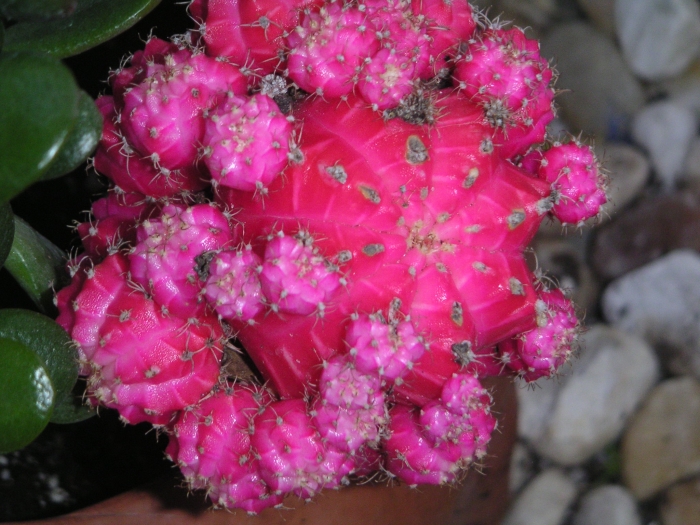Moon Cactus
(Gymnocalycium mihanovichii)
Moon Cactus (Gymnocalycium mihanovichii)
/
/

Myself
CC BY-SA 3.0
Image By:
Myself
Recorded By:
Copyright:
CC BY-SA 3.0
Copyright Notice:
Photo by: Myself | License Type: CC BY-SA 3.0 | License URL: http://creativecommons.org/licenses/by-sa/3.0/ | Uploader: Neutrality | Publisher: Wikimedia Commons | Title: Succulent_close-up.JPG | Notes: |












Estimated Native Range
Summary
Gymnocalycium mihanovichii, commonly known as Moon Cactus, is a semi-deciduous succulent native to the Chaco region in South America, which includes parts of northeastern Argentina, Paraguay, and parts of Bolivia. This plant typically has a globular, gray-green stem that can exhibit reddish hues, reaching heights and diameters of 3 to 5 centimeters. The Moon Cactus is renowned for its 4 to 5 cm long, bell-shaped to funnel-shaped flowers that bloom in shades of yellowish-olive to light olive green. Flowering usually occurs in late spring to early summer and the flowers are quite showy, adding ornamental value.
In its natural habitat, Gymnocalycium mihanovichii is often found growing under the protection of shrubs or grasses, which provides it with filtered sunlight. In cultivation, it is appreciated for its unique appearance and low maintenance requirements. It is commonly used as a houseplant or in cactus and succulent gardens. The Moon Cactus requires bright, indirect light and should be protected from intense direct sunlight, especially during the hottest part of the day. The soil should be well-draining, and the plant should not be left in waterlogged conditions. Watering should be reduced in winter to prevent root rot. This cactus is also popular for grafting onto other cacti to create interesting hybrids. Propagation is typically done through cuttings or offsets. While generally pest-resistant, it can be susceptible to mealybugs and fungal diseases if overwatered or if airflow is poor.CC BY-SA 4.0
In its natural habitat, Gymnocalycium mihanovichii is often found growing under the protection of shrubs or grasses, which provides it with filtered sunlight. In cultivation, it is appreciated for its unique appearance and low maintenance requirements. It is commonly used as a houseplant or in cactus and succulent gardens. The Moon Cactus requires bright, indirect light and should be protected from intense direct sunlight, especially during the hottest part of the day. The soil should be well-draining, and the plant should not be left in waterlogged conditions. Watering should be reduced in winter to prevent root rot. This cactus is also popular for grafting onto other cacti to create interesting hybrids. Propagation is typically done through cuttings or offsets. While generally pest-resistant, it can be susceptible to mealybugs and fungal diseases if overwatered or if airflow is poor.CC BY-SA 4.0
Plant Description
- Plant Type: Succulent
- Height: 0.1-0.3 feet
- Width: 1-3 feet
- Growth Rate: Slow
- Flower Color: White, Pink, Red
- Flowering Season: Summer
- Leaf Retention: Deciduous
Growth Requirements
- Sun: Full Sun, Part Shade
- Water: Very Low
- Drainage: Fast
Common Uses
Drought Tolerant, Low Maintenance, Potted Plant, Showy Flowers, Street Planting
Natural Habitat
Native to the Chaco region in South America, including parts of northeastern Argentina, Paraguay, and Bolivia
Other Names
Common Names: Ruby Ball, Red Cap, Red Hibotan, Hibotan Cacti.
Scientific Names: , Gymnocalycium mihanovichii, Gymnocalycium mihanovichii var. filadelfiense, Echinocactus mihanovichii, Gymnocalycium mihanovichii f. nigrum, Gymnocalycium mihanovichii subsp. albiflorum,
GBIF Accepted Name: Gymnocalycium mihanovichii (Fric & Gürke) Britton & Rose